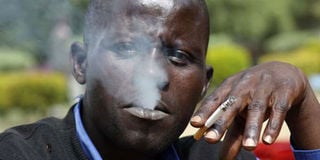11 million Kenyans risk contracting tobacco-related diseases

A smoker at Uhuru Park's smoking zone in Nairobi on June 12, 2013. PHOTO | NATION MEDIA GROUP
What you need to know:
- The World Health Organization (WHO) says the total mortality rate from non-communicable diseases in Kenya stood at 27 per cent in 2014.
- Kenya Stepwise Survey 2015 further indicates that the poor are the heaviest smokers at 18 per cent while the rich constitute of 10 per cent.
At least 11 million Kenyans are daily exposed to second hand smoke at home, putting them at the risk of contracting tobacco-related diseases.
Another 10 million face the same danger at their places of work as most working stations have no smoking zone(s).
Medics are now warning that continued exposure to smoke will increase the risk of contracting chronic respiratory, diabetes, cardiovascular and cancer diseases.
The exposure is also posing a great risk to unborn through maternal, perinatal and nutrition when pregnant mothers are exposed to daily smoke.
The World Health Organization (WHO) says the total mortality rate from non-communicable diseases in Kenya stood at 27 per cent in 2014.
Dr Gladwell Gathecha - who heads violence and injury prevention unit at the Ministry of Health - says men are the heaviest smokers at 17 per cent while only 0.4 per cent women are smokers.
The first non-communicable disease survey titled Kenya Stepwise Survey 2015 further indicates that the poor are the heaviest smokers at 18 per cent while the rich constitute of 10 per cent.
Thirteen per cent of the middle class are chain smokers.
Dr Gathecha says that the average smoking age debut in Kenya is 20, while seven manufactured cigarettes are smoked per day by 93 per cent of Kenyans.
Addiction is the biggest challenge facing smokers and 35 per cent have tried in the past 12 months to stop the harmful habit in vain.
Edited by Philip Momanyi





